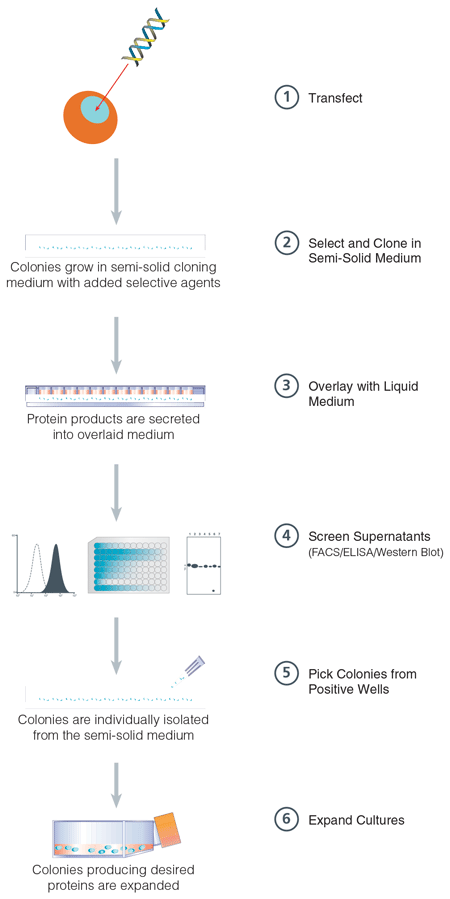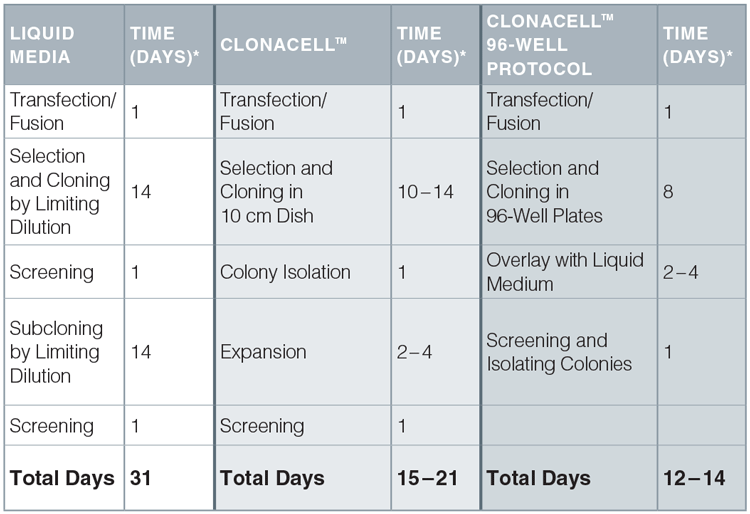Protocol for Cloning CHO Cell Lines Using ClonaCell™-CHO Semi-Solid Medium
.
- Document # 29299
- Version 1.0.1
- May 2023
Reduce the Time Needed to Isolate Producing, Monoclonal Cell Lines
Background
The protocol for semi-solid cloning in 96-well plates combines isolation of discrete colonies, each with a high probability of monoclonality, with the efficiency of selecting and expanding only producing clones. Conventional methods to select and clone mammalian cell lines involve multiple dilution steps in liquid medium. Semi-solid cloning using ClonaCell™ methylcellulose-based media from STEMCELL Technologies Inc. reduces the overall time necessary to produce monoclonal cultures by up to 19 days. ClonaCell™-CHO methylcellulose-based semi-solid media are specifically designed for cloning of CHO cell lines. ClonaCell™-CHO CD is a chemically defined medium that is both protein- and animal component-free. ClonaCell™-CHO ACF is animal component-free and contains recombinant proteins. Using the standard protocol for mammalian cell cloning in ClonaCell™-CHO media, freshly transfected cells are suspended in selective semi-solid medium and incubated in 10 cm plates. Individual cells grow to form discrete, monoclonal colonies that are picked from the semi-solid medium after 10 - 14 days of incubation. Colonies are then transferred to individual wells of a 96-well plate and cultured in liquid medium prior to screening the supernatants for clones of interest.
The following technical note describes the use of ClonaCell™-CHO semi-solid media in 96-well plates to reduce the need to harvest and expand large numbers of colonies before screening (Figure 1). Cells suspended in ClonaCell™-CHO medium are plated directly into individual wells of a 96-well plate. Cells grow in the semi-solid medium as discrete colonies and secrete protein products into the surrounding medium. Liquid medium is layered over the semi-solid medium and the secreted proteins diffuse into the liquid medium, which is then screened to identify colonies producing specific products. This method enables isolation of producing cultures with a high probability of monoclonality after only a single round of cloning. These combined benefits result in considerable time and labor savings.

Protocol
- On the day of transfection, place ClonaCell™-CHO methylcellulose-based semi-solid medium (Catalog #03815, 03816) at 2 - 8°C to thaw overnight. Do not place medium in a water bath to thaw.
- Perform cell transfection.
- Incubate the cells in liquid recovery medium (such as ClonaCell™-CHO CD Liquid, Catalog #03817) without selective agents at 37°C and 5% CO2 in a humidified incubator for 16 - 24 hours.
- On the day after transfection, warm thawed ClonaCell™-CHO semi-solid medium to 37°C.
- Add required growth and selection reagents in liquid growth medium. The total volume of additives and cells must not exceed 10 mL per 90 mL bottle of ClonaCell™-CHO semi-solid medium, such that the final volume of medium, cells and additives is no greater than 100 mL. Shake vigorously to mix the contents of the bottle.
- Determine the optimal number of cells to plate per well to obtain one colony per well. If you already have experience with cloning by limiting dilution, plate the same number of cells per well in the semi-solid medium as you would in liquid medium. Plating at various cell densities is recommended as transfection efficiency may vary from experiment to experiment.
- Resuspend the cells in liquid growth medium (such as ClonaCell™-CHO CD Liquid, Catalog #03817). It is critical that the cumulative volume of the cell suspension added in this step and reagents added in step 5 does not exceed 10 mL.
- Add the cell suspension in liquid growth medium to the semi-solid medium. Mix well and let sit for 15 minutes to allow the bubbles to rise to the surface.
- Using either a multi-channel pipettor fitted with sterile wide-bore pipette tips, or a repeat pipettor with a sterile syringe, dispense 60 - 80 μL of the cells in semi-solid medium into each well of a 96-well plate. This will yield between 12 - 16 plates depending on the volume plated. ClonaCell™-CHO semi-solid medium is viscous and therefore difficult to pipette accurately; however, it is not critical to dispense exactly the same volume into each well.
- Incubate the plates at 37°C in a humidified, 5% CO2 incubator. The incubator should be well-humidified to prevent excessive evaporation. If desired, the plates may be placed inside a plastic container that allows for proper gas exchange (e.g. 245 mm x 245 mm; Catalog #38039/100-0084) along with an uncovered Petri dish containing sterile water.
- Following 8 days of undisturbed incubation, examine wells for the presence of colonies by eye or microscope and gently overlay 150 μL of pre-warmed (37°C) liquid growth medium onto the semi-solid medium of each well that contains colonies. Alternatively, all wells may be overlaid with 150 μL of pre-warmed liquid medium, regardless of the presence of colonies, after which further analysis is performed on all wells.
- Incubate plates at 37°C in a humidified, 5% CO2 incubator for an additional 2 - 4 days. The overlay incubation time may be increased further to ensure the detection of low-expressing clones.
- Carefully remove a maximum of 100 μL of the overlaid liquid medium without disturbing the colonies in the semi-solid medium. Test the supernatants for specific protein products using an appropriate assay system (e.g. ELISA, flow cytometry, Western blotting).
- Cultures in wells that test positive for desired protein products should be expanded by gently resuspending the contents and transferring them to a single well of a 24-well plate containing 1 mL of liquid growth medium. If a well contains more than one colony, it may be possible to harvest the clones separately using a pipette and transfer them to individual wells for expansion and retesting. If wells contain more than one colony and harvesting of individual colonies is not possible, the cultures need to be recloned either immediately after harvesting or after a 1 - 2 day recovery and expansion period in liquid medium. Recloning is not necessary for positive clones that can be harvested independently as these colonies should already be monoclonal. It is useful, however, to reclone these cultures when selecting for stable, high-producing subclones.
Time Comparison of Limiting Dilution Cloning, ClonaCell™ Semi- Solid Cloning, and ClonaCell™ 96-Well Semi-Solid Cloning Protocols

*Selection and cloning times may vary depending on the selection system used
Request Pricing
Thank you for your interest in this product. Please provide us with your contact information and your local representative will contact you with a customized quote. Where appropriate, they can also assist you with a(n):
Estimated delivery time for your area
Product sample or exclusive offer
In-lab demonstration

